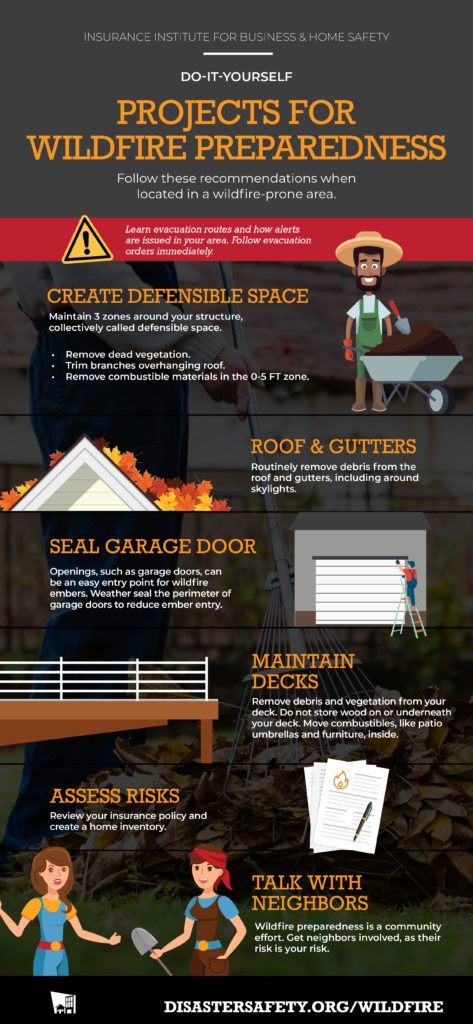
Make your home wildfire ready

While there are many things you can do to help protect your home from wildfire, these critical actions are essential to making a meaningful reduction in your risk. Together, these steps are the most important and can begin to give your home the best chance of survival. Do these first!
Make sure your roof is fire-rated:
Roofs are rated Class A to Class C based on their fire resistance with Class A providing the most protection from fire. Some roofs are not rated for protection against fires. If your roof is unrated, or if you are considering replacing your roof, re-roof with a Class A-rated roofing material.*
- Nearly all asphalt shingles currently on the market are Class A fire-rated. Three-quarters of all homes in the United States have a Class A asphalt shingle roof.
- Clay and concrete tile roofs are Class A.
- If you have a tile roof, bird-stop open ends of tiles at the roof edge to reduce vulnerability.
Create a buffer around your home (0-5 foot home ignition zone)
Pay special attention to the 5 feet immediately around your home. This area should be designed and maintained to keep fire or embers from igniting materials in this area and spreading fire to your home. Ensure yard debris and dead plant material does not accumulate in this zone.
- Use hardscape like gravel, pavers, concrete, and other noncombustible mulch materials in this 5-foot zone around your home.
- While best practice is to have no vegetation, choosing limited use of CalFire-recommended vegetation will keep your risk low.
- Do not park boats, RVs, or other vehicles in this zone.
- Do not store firewood, outdoor furniture, or other items such as trash cans, pet houses, lawn tools, children’s playsets, etc., in this zone.
- Ensure that where the lowest 6 inches of the exterior wall meets the ground is covered with a noncombustible material such as brick, stone veneer, or exposed concrete of the foundation.
Remove items under your deck
To prevent your deck from igniting and spreading fire to your home, do not use the area under decks as long-term storage.
- It is best practice to store items long-term either indoors or at least 30 feet from the home if possible. It is also a good habit to avoid storing any items under your deck, even temporarily, and to consider this area as part of your home ignition zone.
- If not possible, on days with Red Flag warnings (when there is high fire danger), plan to move any items temporarily stored beneath the deck―as well as outdoor furniture and other items that may be on top of your deck―indoors, into your garage, or at least 30 feet from your home. (But be mindful not to place them near your neighbors.) However, note that this is not ideal as it wastes valuable time if a fire develops near you and evacuation is necessary.
Add or upgrade your vent screens
Flying embers can enter your home through vents in your attic, roof, gables, and crawlspace. Make sure vents have a metal screen 1/8 inch or finer to block embers from entering and igniting your home. Be sure to check screens periodically and remove accumulated debris, birds’ nests, etc.
Trim Trees
- Remove branches that may overhang your roof or gutters.
- Trim the bottom of trees so that all branches are at least 6 feet from the ground and at least 3 times higher than any shrubs nearby.
- Trim upper branches of trees to ensure they are at least 10 feet away from branches of neighboring trees.
- Work with your neighbor to address trees near your property line that affect both properties.
For more information and additional tips on Wildfire Prevention visit: https://disastersafety.org/wildfire/wildfire-ready/
Source: DisasterSafety.org
Categories: Blog
